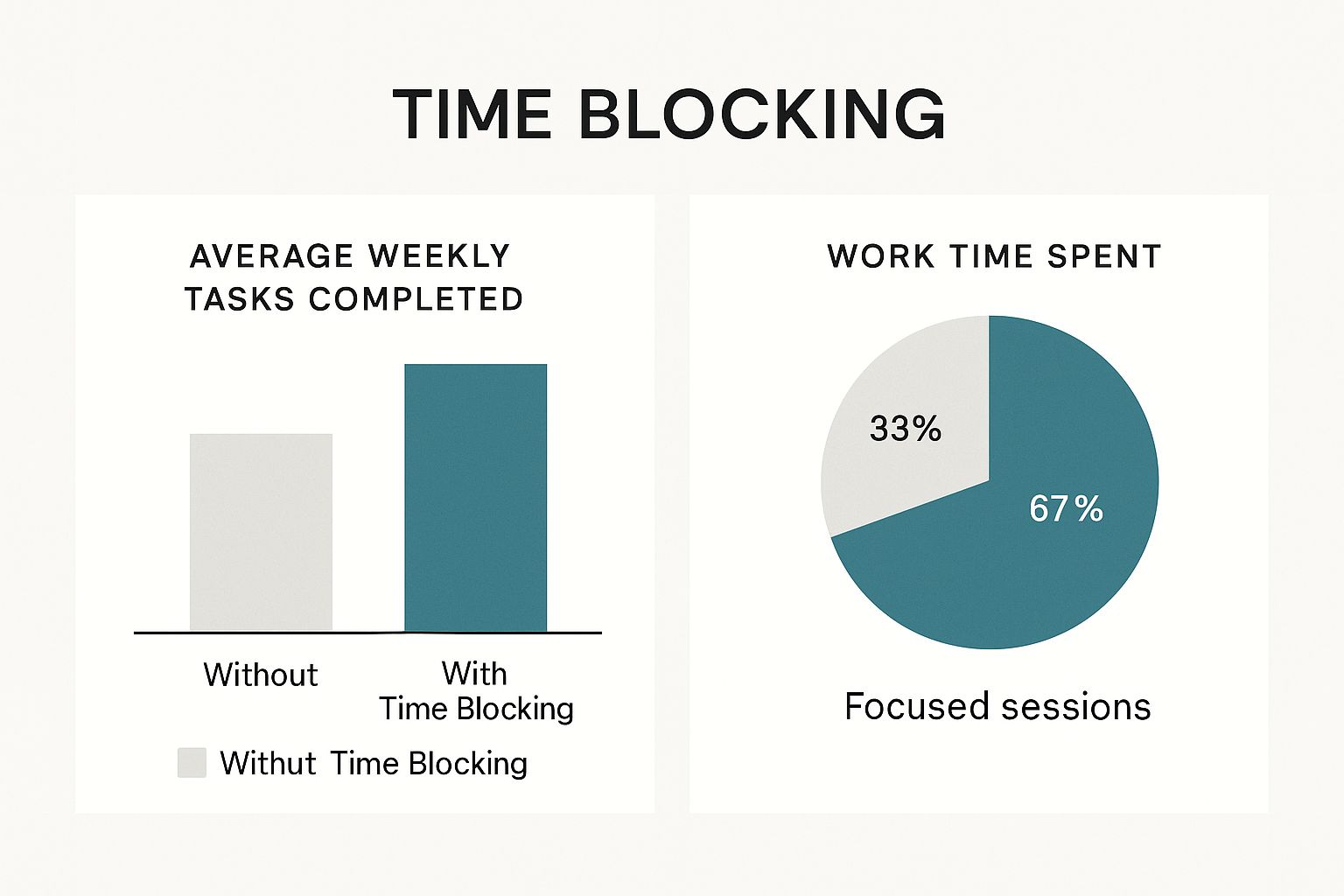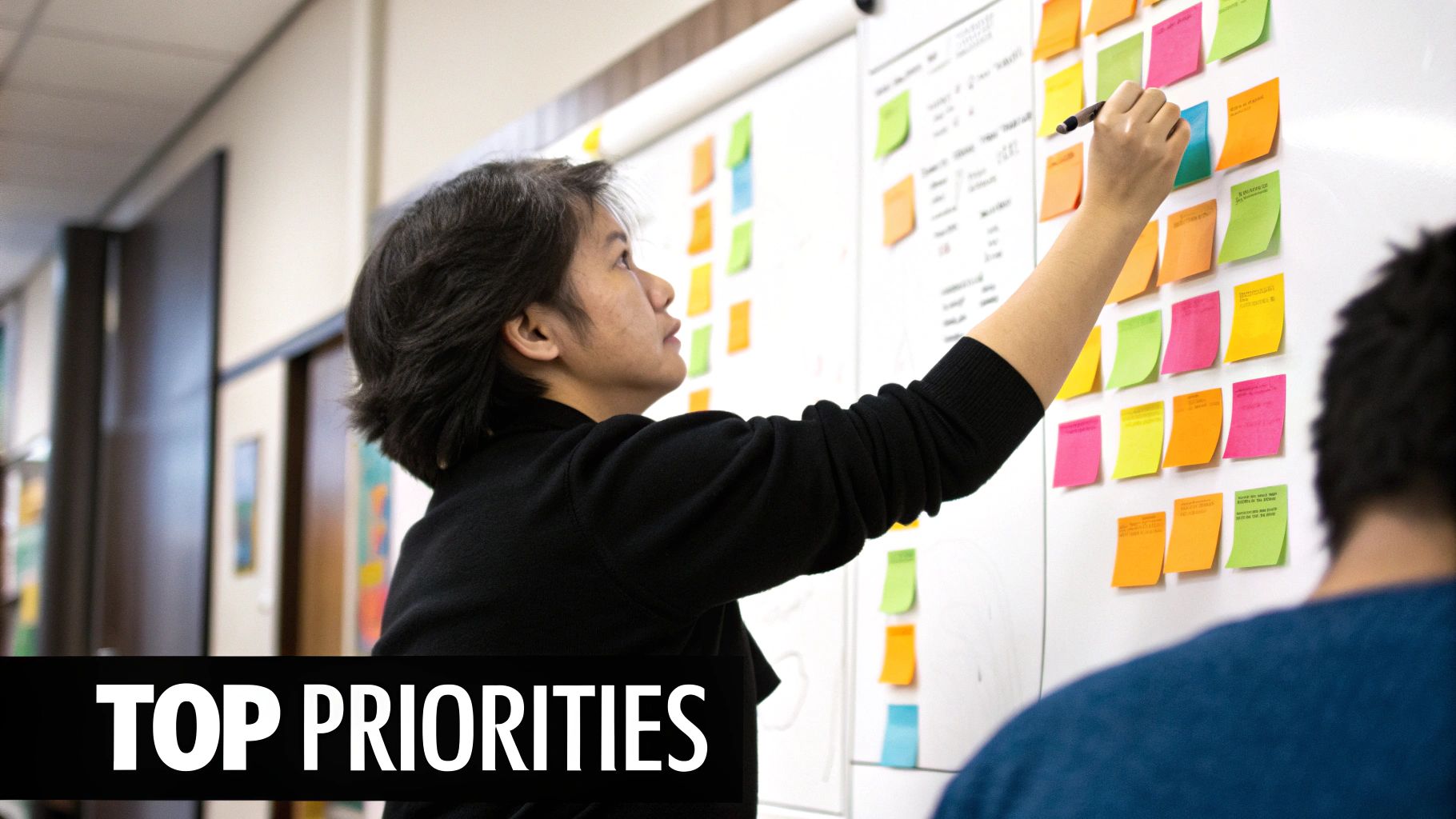
How to Meet Deadlines: Proven Strategies for Success
Share
The Hidden Impact of Deadline Management on Career Trajectory
Meeting deadlines consistently isn't simply about checking items off a list. It's about cultivating a reputation as a dependable and results-driven professional. This seemingly straightforward practice has a significant impact on your career path, influencing everything from promotions to the kinds of projects you're assigned. For instance, consistently delivering work on time demonstrates to management that you can be entrusted with more responsibility.
This trust leads to tangible advantages. Individuals who reliably meet deadlines are often the first considered for promotions and high-profile projects. Moreover, meeting deadlines cultivates confidence, both in yourself and within your team. It reinforces the understanding that you can manage pressure and deliver results, even within tight timeframes.
This sets you apart and establishes you as a valuable resource within any organization. You might be interested in: How to master...
The Trust Premium and Career Advancement
Meeting deadlines builds trust, and trust is essential for career progression. When you consistently demonstrate your ability to meet deadlines, you're not just finishing tasks; you’re building a trust premium. This premium creates opportunities that might otherwise be unavailable.
Effective deadline management is vital for productivity and efficiency. Research indicates that businesses using structured project management practices experience a 38% higher project success rate compared to those lacking a defined system. This underscores the importance of planning and task management for timely results. Find more detailed statistics here: Task Management Statistics
Psychological Advantages of Deadline Mastery
Beyond the external rewards, mastering deadlines provides significant psychological benefits. Successfully managing deadlines reduces cognitive load, freeing up mental capacity for strategic thinking and creative problem-solving. This allows you to concentrate on the work itself, instead of the impending pressure of the deadline.
Furthermore, consistently meeting deadlines fosters a sense of accomplishment and control. This, in turn, minimizes stress and increases overall job satisfaction. It shifts the focus from worrying about meeting the deadline to the satisfaction of achieving an objective. Instead of feeling overwhelmed, you feel empowered, contributing to a more positive and productive work experience.
Rewiring Your Relationship With Time and Commitment

Meeting deadlines successfully involves more than just managing tasks. It requires developing a healthy relationship with time and commitments. This includes understanding your own personal relationship with deadlines and implementing strategies to optimize your approach. This shift in perspective can significantly improve your ability to consistently deliver on time.
Identifying and Neutralizing Procrastination Triggers
Procrastination often arises from specific triggers, such as fear of failure or feeling overwhelmed. The first step towards overcoming procrastination and meeting deadlines is identifying these personal triggers. For instance, if you consistently postpone tasks involving public speaking, performance anxiety might be your trigger.
Once you've pinpointed your triggers, you can develop strategies to counteract them. This might involve breaking down large tasks into smaller, more manageable steps. You could also explore mindfulness techniques to reduce anxiety or seek support from colleagues or mentors. Addressing these root causes is essential for long-term success in meeting deadlines.
Leveraging Implementation Intentions and Visualization
Implementation intentions involve creating "if-then" plans to proactively address potential obstacles. For example, if you feel the urge to check social media while working on a project, then you will set a timer for 15 minutes and only check it after completing a specific task.
Combined with implementation intentions, visualization can be a powerful tool. Visualizing yourself successfully completing a task can boost your motivation and confidence. This mental rehearsal can make the actual task feel less daunting and increase the likelihood of adhering to your plan. By mentally preparing for success, you create a positive feedback loop that reinforces productive behaviors.
Micro-Commitments and Strategic Deadline Buffers
Micro-commitments involve breaking down large projects into small, actionable steps. This approach makes the overall project less intimidating and provides a sense of accomplishment as you complete each micro-commitment. These small wins generate momentum and contribute to a sense of ongoing progress.
Adding strategic deadline buffers can also account for unexpected delays. Including a buffer of a day or two to your internal deadline provides a cushion for unforeseen circumstances. It's crucial, however, to avoid using these buffers as an excuse to procrastinate. Treat the buffered deadline as the real deadline and utilize the extra time only if absolutely necessary. This provides a realistic margin of safety without encouraging unnecessary delays. Integrating this safety net into your schedule reduces stress and enables you to navigate unexpected obstacles more effectively.
Blueprint: Designing Projects That Finish On Time, Every Time

Consistently meeting deadlines hinges on meticulous planning before a project even begins. Just as an architect wouldn't break ground without a blueprint, successful projects require a detailed roadmap. The following sections explore the key project design strategies used by high-performing teams and individuals, offering practical guidance on achieving deadline success. This data chart visualizes success rates and key features of different project management methodologies. Agile methodologies, with their adaptable nature, demonstrate higher success rates.
Backward Planning: Working From the Due Date Back
Backward planning, also called retrograde planning, is a highly effective technique. Start with your deadline and work backward, outlining all the necessary steps. This approach helps identify potential roadblocks early on, allowing for a more realistic schedule.
For example, if a presentation is due in two weeks, backward planning would involve scheduling practice sessions, content creation, research, and initial brainstorming, each with its own mini-deadline. This ensures that all necessary steps are accounted for and correctly sequenced.
Milestone Sequencing: Maintaining Momentum and Avoiding Bottlenecks
Establishing clear milestones is essential for maintaining project momentum. Think of milestones as checkpoints along your project timeline. They divide large, complex tasks into smaller, more manageable parts.
Proper milestone sequencing prevents bottlenecks by ensuring tasks are completed logically, considering dependencies between activities. Effective time tracking also plays a crucial role in meeting deadlines. Studies show that the average worker spends roughly 51% of their time on low-value tasks. By implementing time tracking systems, businesses can reduce these productivity losses by 80% and increase revenue by 61%. For more on this topic, see Time Management Statistics.
Buffer Systems: Absorbing Disruptions Without Derailing Timelines
Rarely do projects unfold exactly as planned. Building buffer systems into your project plan accounts for unexpected delays. These buffers can be time-based (adding extra days to a task) or resource-based (having backup personnel).
A well-placed buffer can prevent a minor setback from escalating into a major deadline issue. Consider them shock absorbers, helping your project navigate unforeseen challenges.
Choosing the Right Planning Framework
Different planning frameworks suit different project types. Time-blocking is effective for individual tasks and daily schedules, while the Critical Path Method (CPM) is better suited for complex projects with interconnected dependencies. To help you choose, the following table compares several planning methods:
Planning Methods Comparison for Deadline Management: This table compares different planning methodologies and their effectiveness for various types of projects and deadlines.
| Planning Method | Best For | Implementation Difficulty | Effectiveness for Short Deadlines | Effectiveness for Long-Term Projects |
|---|---|---|---|---|
| Time-Blocking | Individual tasks, daily schedules | Easy | High | Moderate |
| CPM | Complex, interconnected projects | High | Moderate | High |
| Kanban | Visualizing workflow | Moderate | Moderate | High |
| Scrum | Collaborative projects | Moderate | High | High |
This table summarizes the strengths and weaknesses of each planning method, assisting you in selecting the best fit for your specific project needs and constraints. Choosing the right framework, along with understanding your personal work style, can significantly improve your ability to deliver on time.
Digital Arsenal: Tools That Transform Deadline Performance

Selecting the right digital tools can significantly improve your ability to meet deadlines. Just as a skilled craftsperson needs the correct tools, so too do professionals in today's demanding work environment. This section explores how to choose and implement tools that truly enhance deadline performance, avoiding the trap of adding unnecessary complexity. The key is to find tools that address your specific needs, not just the latest popular apps.
Evaluating Your Needs: Finding The Right Fit
Before exploring the numerous productivity apps available, analyze your existing workflow. Where are the biggest obstacles to meeting deadlines? Are you struggling with planning, execution, or communication? Perhaps a comprehensive project management platform is necessary, or maybe a simple time tracker will be sufficient.
For example, if missed deadlines stem from poor planning, a project management tool with Gantt charts might be the solution. If your challenge is maintaining focus, a website blocker might be more beneficial. Pinpointing the root cause of deadline struggles is the first step in finding the right digital solution.
From Project Management to Time Tracking: Essential Tool Categories
Several categories of digital tools can dramatically improve deadline performance:
-
Project Management Platforms: These tools offer features like task management, team collaboration, Gantt charts, and progress tracking. They create a central hub for all project-related information, keeping everyone aligned.
-
Time Tracking Software: Understanding where your time is spent is essential for accurate planning and efficient execution. Time trackers reveal how you spend your workday, helping you identify time-wasting activities and improve estimations.
-
Communication Tools: Effective communication is critical for meeting deadlines, especially for teams. Tools like Slack or Microsoft Teams enable instant communication, minimizing delays caused by email.
-
Calendar and Scheduling Apps: These tools help visualize deadlines, schedule meetings, and manage your overall time. Integration with other tools, like your email or project management platform, streamlines your workflow.
-
Focus-Enhancing Tools: Distractions are a major impediment to meeting deadlines. Website blockers and focus timers minimize interruptions, enabling focused work and increased productivity. Check out our guide on How to master... for additional tips.
Implementing Tools Effectively: Avoiding Tool Overload
Simply installing a new app isn't enough. Successful tool implementation requires a strategic approach:
-
Start Small: Begin with one or two essential tools and become proficient with them before adding more. Too many tools can be counterproductive.
-
Integrate Tools Seamlessly: Choose tools that integrate well with your existing systems and with each other. This minimizes data silos and improves overall efficiency.
-
Train Your Team: If you work in a team, ensure everyone understands how to use the chosen tools. This prevents confusion and maximizes the benefits of collaboration.
-
Regularly Review and Refine: Your needs may evolve. Periodically review your toolset and remove any tools no longer contributing to your deadline management goals.
Building a Tech Ecosystem That Works For You
The ultimate goal is to create a digital ecosystem that simplifies meeting deadlines. This involves selecting the right tools, implementing them effectively, and regularly evaluating their performance. By focusing on tools that truly enhance productivity, you can transform deadline pressure from a source of stress into a catalyst for success. Remember, it's about the effectiveness of your tools, not the quantity. This integrated approach allows you to work smarter, not harder.
Triage and Focus: Managing Multiple Competing Deadlines

Mastering deadlines isn't simply about checking off individual tasks; it's about effectively juggling multiple commitments. This requires a strategic approach to prioritization, understanding which tasks demand immediate attention and which can wait. This section explores the frameworks and strategies successful professionals use when everything feels equally urgent. For enhanced productivity, consider incorporating tools like best voice to text software.
Beyond Urgency: Evaluating True Business Impact
Many prioritize tasks based on urgency, tackling the nearest deadline first. However, this approach can lead to overlooking tasks that offer greater long-term value. Successful professionals differentiate between perceived urgency and actual business impact.
For example, replying to a non-critical email may feel urgent, but spending that time finalizing a key proposal could significantly impact your business objectives. This requires careful evaluation and the ability to resist the immediate pressure of seemingly urgent, but less important, tasks. For more tips on time management, see: How to master...
Communication Strategies for Managing Stakeholder Expectations
When deadlines clash, clear communication becomes paramount. Keeping stakeholders informed about potential delays and revised timelines is essential for maintaining trust and managing expectations. This proactive communication fosters stronger professional relationships and prevents misunderstandings.
Learning to negotiate deadline adjustments is also a valuable skill. Clearly articulating the reasons for the request and offering alternative solutions can lead to a mutually beneficial outcome.
Batch Processing and Strategic Task-Switching
Batch processing, grouping similar tasks, can significantly boost efficiency. For instance, dedicating a specific time block for answering emails, rather than checking them intermittently, minimizes distractions and maximizes focus.
However, strategic task-switching can also be beneficial. Feeling stuck on a complex problem? Shifting to a different task can provide a mental break, allowing you to return to the original challenge with renewed focus. This requires self-awareness and understanding your personal work rhythms.
Decision Framework for Prioritization
When faced with numerous competing deadlines, a structured decision-making framework is crucial. The following table provides a practical approach for prioritizing tasks based on urgency and impact:
Deadline Prioritization Framework: A decision-making matrix to help readers determine which deadlines to tackle first when managing multiple competing tasks.
| Priority Level | Urgency Factors | Impact Factors | Resource Requirements | Recommended Action |
|---|---|---|---|---|
| High | Immediate deadline, critical dependency | Significant impact on project/business goals | High/Medium | Address immediately |
| Medium | Approaching deadline, moderate dependency | Moderate impact on project/business goals | Medium/Low | Schedule dedicated time |
| Low | Distant deadline, low dependency | Minimal impact on project/business goals | Low | Delegate or defer if possible |
This framework helps you quickly assess each task's relative importance, making informed decisions about where to focus your energy. By considering both urgency and impact, you can ensure your time is spent on activities that contribute most effectively to your overall objectives. This structured approach enables you to navigate demanding situations and maintain control, even under pressure.
Salvaging Success: Overcoming Deadline Derailment
Even with the best laid plans, projects can get off track. Unexpected roadblocks can appear and threaten deadlines. This is known as deadline derailment, and knowing how to handle these situations is essential for continued project success. This section explores effective strategies for identifying warning signs and implementing recovery protocols to get your projects back on course.
Early Warning Signs: Detecting Potential Problems
Recognizing the early warning signs of deadline derailment is critical. Just like a small leak in a dam, addressing these issues early can prevent a major crisis. Some common warning signs include:
- Missed Milestones: If project milestones are consistently being missed, it's a clear indication that the project is veering off track.
- Communication Breakdown: Poor communication or increasing tension within the team can often signal underlying problems that need to be addressed.
- Scope Creep: The gradual expansion of a project's scope beyond the original plan can quickly deplete resources and lead to delays.
- Unforeseen Dependencies: Discovering unexpected dependencies on external factors can significantly impact the project timeline.
These seemingly minor issues can quickly escalate, so proactive intervention is key.
Rapid Reassessment: Adjusting Your Approach
When new information emerges that jeopardizes a deadline, a rapid reassessment is crucial. This involves a few key steps:
- Analyzing the Impact: Carefully determine the severity of the disruption and how it affects the overall project timeline.
- Evaluating Options: Consider if adjustments to the current approach are sufficient, or if resources need to be reallocated.
- Communicating with Stakeholders: Keep stakeholders informed about the situation and any necessary changes to the project plan.
This process allows for an informed response, maintaining transparency and building trust with stakeholders. When dealing with numerous deadlines, prioritizing tasks effectively is essential. Consider exploring various task prioritization methods to improve efficiency.
Communication Templates: Updating Stakeholders Effectively
Communicating about deadline issues requires careful thought. Using pre-crafted communication templates can help you convey updates professionally and maintain stakeholder confidence. These templates should include:
- A clear explanation of the issue: Clearly and transparently explain the reason for the delay.
- A revised timeline: Provide a realistic and updated timeline for project completion.
- A plan of action: Outline the steps being taken to address the issue and mitigate further delays.
This structured approach minimizes anxiety and reinforces your dedication to delivering the project, even when faced with setbacks. For additional resources on project management and communication, you might find value in exploring resources like How to master....
Managing the Psychological Impact: Overcoming Setbacks
Deadline pressure can have a significant psychological impact. Perfectionism, decision paralysis, and dips in motivation can all contribute to deadline derailment. Overcoming these challenges involves:
- Self-Awareness: Understand your own tendencies and implement strategies to manage them proactively.
- Seeking Support: Don't hesitate to reach out to colleagues, mentors, or support networks for guidance and assistance.
- Celebrating Small Wins: Acknowledging progress, regardless of how small, helps maintain positive momentum and boosts morale.
By addressing both the logistical and psychological aspects of deadline challenges, you can build resilience and maintain focus, even under pressure. This comprehensive approach enables you to not just meet deadlines, but to excel throughout the entire project lifecycle. Remember that occasional setbacks are inevitable; it’s your response to them that truly defines your success.
Building Your Deadline Mastery System For Lasting Success
Meeting deadlines consistently isn't just about short-term wins; it's about building a sustainable system for long-term success. This goes beyond simply using the right tools or tactics. It requires developing personalized rituals and routines that become second nature. This section explores how to create a deadline mastery system that evolves with your professional growth and transforms deadline pressure from a source of stress into a driver of achievement.
Developing Deadline Rituals And Routines
Just as athletes have pre-game rituals, developing consistent deadline routines can significantly improve performance. These routines signal to your brain that it's time to focus and deliver. This could involve clearing your workspace, turning off notifications, or reviewing your project plan.
These rituals don't need to be complex, but they should be consistent. Over time, they become ingrained habits that trigger a productive mindset, setting the stage for focused work and timely completion. This consistency creates a mental association between the ritual and the task at hand, promoting efficiency and reducing procrastination. Learn more in our article about How to master…
Conducting Effective Project Post-Mortems
Even after a project is complete, valuable lessons can be learned. Project post-mortems, reviewing both successes and failures, provide crucial insights for continuous improvement. This involves analyzing what went well, what could be improved, and identifying any recurring obstacles.
This reflective practice helps refine your deadline management system over time. By extracting lessons from past experiences, you can identify patterns and develop strategies to prevent similar challenges in future projects. This creates a continuous feedback loop, allowing you to optimize your approach and consistently improve your deadline performance. This ongoing refinement is essential for adapting to evolving project demands and maintaining a high level of effectiveness.
Building Contextual Deadline Templates
Creating deadline templates for recurring project types can save significant time and effort in future planning. These templates serve as a starting point, outlining key tasks, milestones, and estimated timelines. This allows you to quickly adapt the template to the specific context of each new project, rather than starting from scratch.
For example, if you regularly manage marketing campaigns, a template could outline the typical phases, from planning and content creation to promotion and analysis. This allows for quick adaptation and consistent execution across similar projects, saving valuable time and ensuring that key steps aren't overlooked. This standardized approach streamlines the planning process and promotes efficiency.
Implementing Personal Guardrails And Accountability Structures
To prevent overcommitment, it's crucial to establish personal guardrails. This means realistically assessing your capacity and saying no to requests that exceed your available time and resources. This self-awareness is critical for maintaining a sustainable workload and avoiding burnout.
Accountability structures can further reinforce positive deadline behaviors. This can involve sharing your deadlines with a colleague or using a project management tool that tracks progress. External accountability can provide additional motivation and encourage consistent effort. This can also involve leveraging social dynamics within a team to create a supportive and collaborative environment.
Reward Systems And Adaptability
Establishing a reward system can reinforce positive deadline behaviors. This could involve celebrating milestones with a small treat or taking a break after completing a challenging task. However, it’s important to avoid creating dependency on external motivation; the primary driver should be the intrinsic satisfaction of achieving your goals.
Finally, your deadline mastery system needs to be adaptable. Organizational changes, role transitions, and increased responsibility require adjustments to your strategies and routines. This adaptability ensures your system remains effective in the face of evolving demands and contributes to long-term success in managing deadlines.
